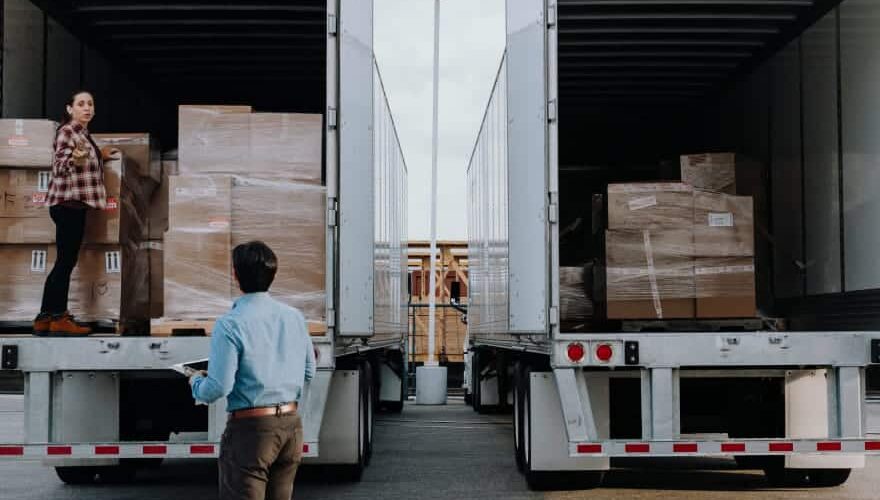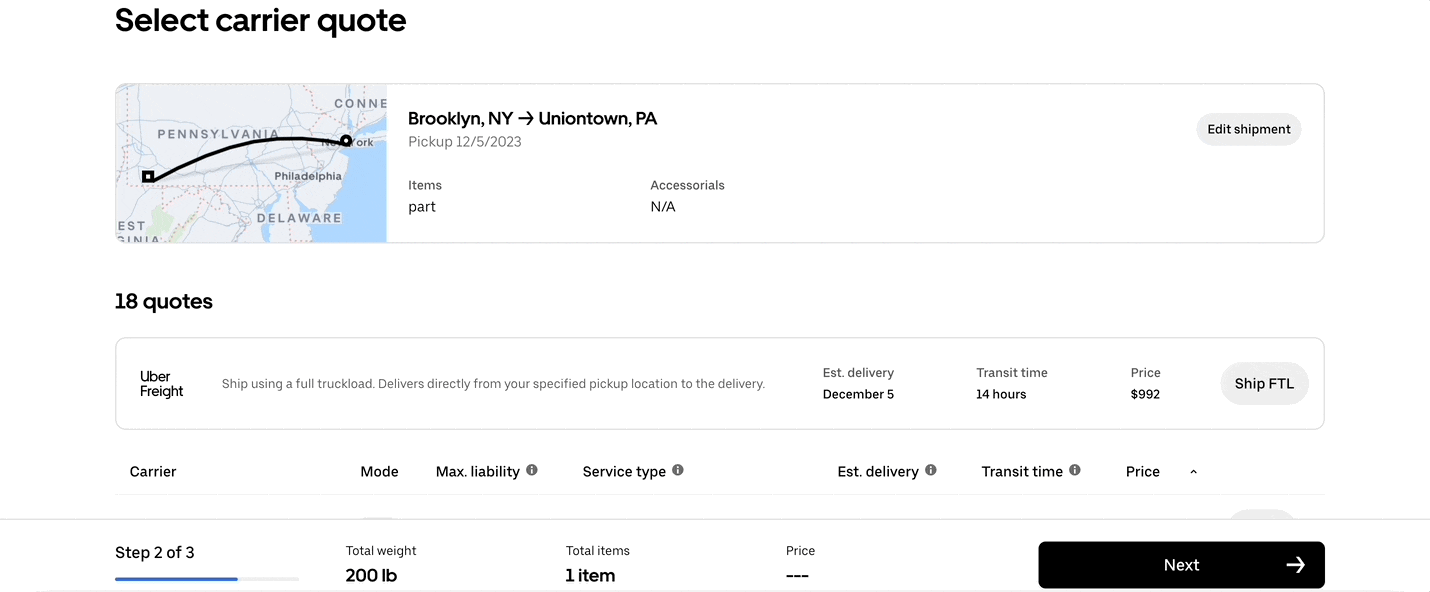LTL vs. FTL Shipping modes: What’s the difference?

With freight demand having significantly slowed down over the course of 2023, shippers now have more flexibility of choice than ever. In an advantageous market with access to more competitive, low-cost carrier options, LTL vs. FTL may not seem like such a tough decision today. But Yellow’s recent bankruptcy filing—which eliminated most of the nation’s overcapacity—and growing anticipation of market stabilization mean this flexibility of choice is unlikely to last for long.
As market conditions shift, shippers should be keeping up with trends and ongoing developments when deciding between LTL and FTL.
Read on to uncover tips for deciding whether LTL or FTL is the right choice for your upcoming loads. Ready to get started? Sign up on Shipper Platform now to compare quotes and explore our freight shipping services.
LTL & FTL Explained
Choosing between full truckload (FTL) and less-than-truckload (LTL) shipping can make or break the profitability of your logistics operations. It’s a decision that requires careful consideration, and one that hinges on a myriad of factors—from market trends, to the nature of your cargo, to the shipment’s time-sensitivity.
What is LTL?
LTL is the common abbreviation for less-than-truckload. LTL shipping is a logistics method where multiple smaller loads from different shippers are consolidated into a single truck for transportation. LTL is typically the preferred method for shippers with relatively small loads that don’t require the capacity of an entire truck. This shipping strategy allows shippers to share costs while enabling carrier efficiency.
What is FTL?
FTL, or full truckload, is what most people might imagine when thinking about freight trucking. In this case, shippers utilize the entire capacity of a truck. FTL is ideal for shippers who have a large enough load, require exclusivity or privacy for their shipment, or are able to secure a more competitive rate for the entire truck. It also offers direct and expedited delivery, as these trucks travel directly from the pickup point to the destination of the sole shipper.
LTL vs. FTL: Comparing both options
When deciding between LTL vs. FTL, shippers should consider a number of factors, including load size, cost, time, and flexibility.
Each shipping method offers different advantages that better aligns with specific priorities. Freight sharing through LTL shipping may offer increased cost-efficiency and flexibility, but with longer transit times. On the other hand, FTL’s exclusivity ensures faster transit, but at potentially higher costs. Depending on what your top priority is, one method might be a better fit than the other.
Load size and capacity
For shippers with smaller loads that won’t fill an entire truck, LTL is usually the best option. This method means shippers only pay for the space they need instead of wasting additional money on an entire truck. On the flipside, if a shipment requires an entire truck, FTL is the way to go. The potential cost savings from splitting a load up into multiple LTL shipments likely won’t make up for the added logistical complexity and extra time.
Cost efficiency
In general, LTL tends to be more cost-effective for smaller shipments because this method allows the cost of an entire truck to be split among multiple shippers.
But even shippers with smaller loads should keep FTL in mind in case LTL rates jump. Especially in the latter half of 2023, market fluctuations could mean a better deal on FTL. Yellow’s bankruptcy has cut into overcapacity significantly. The carrier and its subsidiaries made up 9% of the LTL market share—which, coincidentally, was around the same percentage of overcapacity in the market before its collapse. While carriers rapidly adjust to secure Yellow’s volume, shippers are likely to see an increase in LTL rates over the next few months.
Transit time
Shippers handling time-sensitive loads should take advantage of direct delivery offered by the exclusivity of FTL shipments. Without stops in between for any other shipments, FTL will get your shipments where they need to go faster than LTL. If transit time is less of a priority, LTL might be the better option. In this case, loads are consolidated and the carrier is making multiple stops along the route, ultimately lengthening the delivery time but lowering overall costs.
Flexibility and handling
LTL carriers have established networks and routes to handle multiple stops, enabling them to adapt to changing shipping needs, make pickups from different origins, and service diverse destinations efficiently. This ability to cater to a wide array of shipping requirements makes LTL a more flexible option compared to FTL.
With FTL, shippers will schedule a firm pickup time and location. This option gives shippers complete control over the pickup, route, and delivery but might require a larger commitment as the entire truckload has to be ready at one location.
Environmental impact
The consolidation of LTL makes it the more environmentally friendly option. An LTL truck always carries cargo, and the vast network of LTL shipments means no empty miles between loads. On the other hand, FTL can create more waste; limiting the whole truck to one shipper can result in underutilized space.
Empty miles comprise ~20%-35% of US trucking miles. Each empty mile traveled equates to wasted fuel, higher costs, unnecessary road congestion, and preventable carbon emissions. Choosing LTL over FTL is just one strategy that shippers can use to help reduce this figure.
No matter which option shippers choose, Uber Freight can offer support throughout the entire process. Our experts are equipped to support a variety of shipment needs, and our suite of technology offerings includes real-time tracking and visibility for shippers’ peace of mind. Our Shipper Platform enables you to compare FTL and LTL quotes at the same time.

Choosing between LTL vs. FTL
The choice between LTL and FTL can be a difficult one, depending on a shipper’s business needs. It can even change based on the business purpose of a particular shipment.
Example: Furniture store restock
Best fit: FTL
When restocking a furniture store with a significant volume of goods, an FTL shipment is the better choice. The large size and bulky nature of the cargo will most likely require an entire truckload. Utilizing FTL ensures exclusive use of the truck’s space, minimizing the risk of damage during transit and providing faster delivery since the truck can move directly from the supplier to the store without any intermediate stops.
Example: Retail store apparel restock
Best fit: LTL
In contrast to furniture, apparel’s smaller loads make LTL a more suitable option. Retail stores with apparel typically involve a mix of styles, sizes, and quantities. LTL is a better fit as it allows for consolidation of these varied shipments from different suppliers. This shipping strategy offers cost-efficiency, ensuring that the retailers receive a range of apparel products to restock their shelves without having to wait until a full truckload is accumulated.
Example: Fresh produce distribution
Best fit: LTL
Distributing fresh produce such as fruits and vegetables to multiple retailers necessitates a flexible and cost-effective approach, making LTL the better fit. Perishable goods often need to be distributed to several locations, and the quantities may vary based on demand and supply. LTL’s ability to consolidate shipments from different suppliers and share the truck’s space allows for efficient delivery to diverse destinations, minimizing waste and ensuring timely distribution of fresh produce.
Example: Temperature-sensitive pharmaceuticals
Best fit: FTL
Though produce and pharmaceuticals typically require similar levels of refrigeration, pharmaceuticals require additional sensitivity and security depending on the nature of the product. FTL is preferred for such shipments as it allows for monitoring throughout the journey and, of course, dedicated temperature control. Moreover, FTL shipping is best for ensuring exact specifications and exclusivity, building an additional layer of protection for sensitive products.
The right choice of method will depend on each shipment, but Uber Freight’s team of logistics experts is always ready to help your business make the best decision. Whether it’s FTL, LTL, or a combination of both, Uber Freight has a suite of support offerings that can fit the needs of your business. Connect with a representative or sign up on Shipper Platform today where you can compare FTL and LTL quotes at the same time and in one place.



